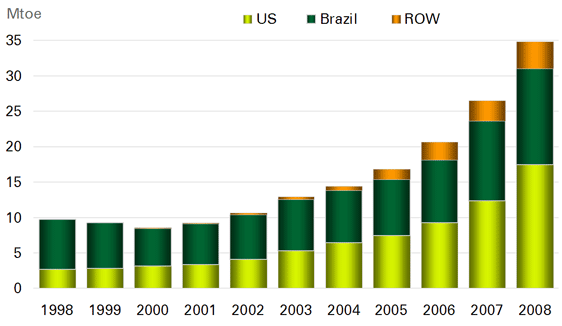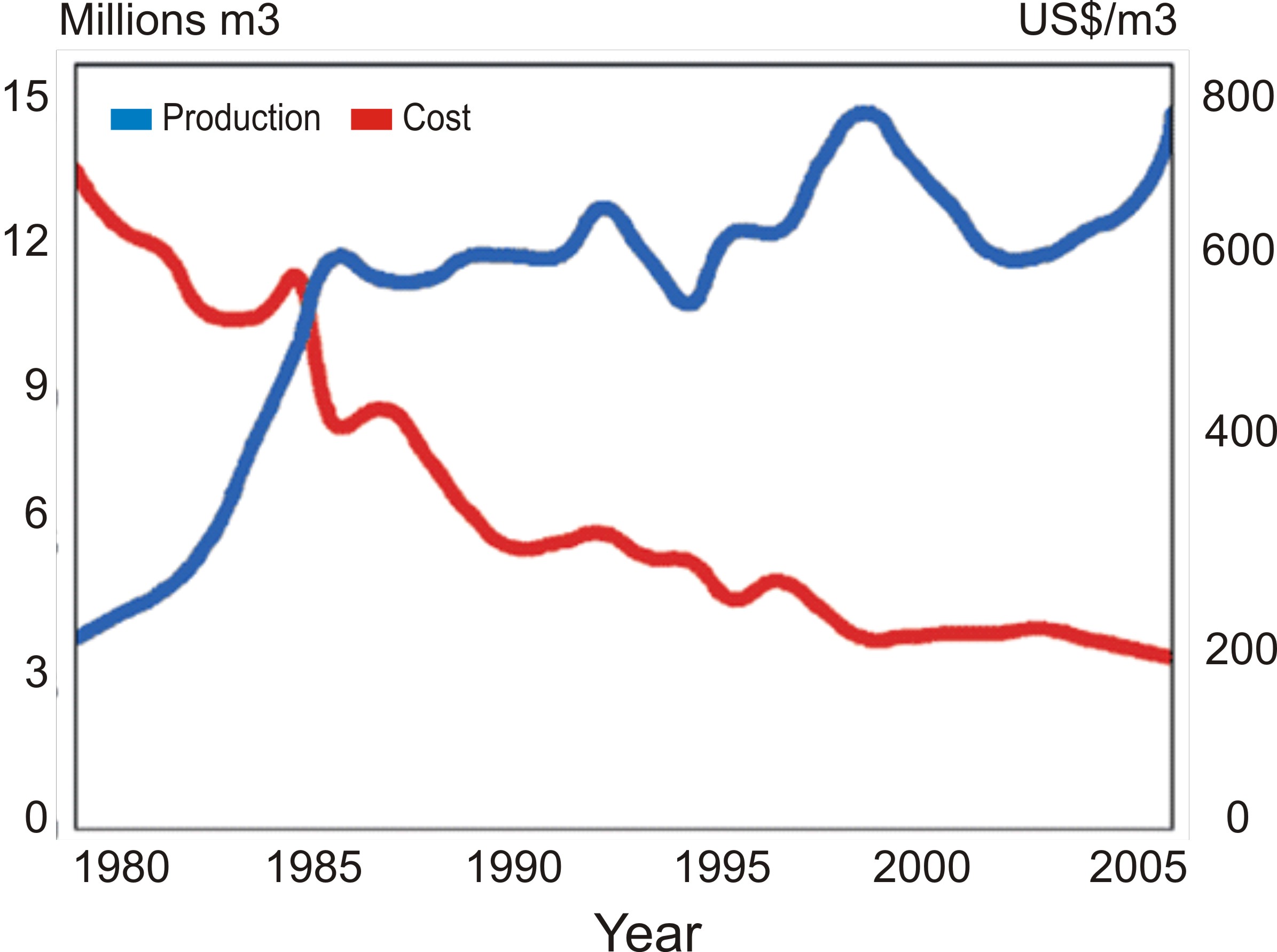Team:UNICAMP-Brazil/Yeastguard/Overview
From 2009.igem.org
| Line 9: | Line 9: | ||
| - | The greatest challenge of this project consists of characterizing a lactate-inducible promoter that is not subjected to glucose catabolic repression, since the device must be activated during the process of sugar fermentation of the diauxic shift of ''S. cerevisiae''. | + | The greatest challenge of this project consists of characterizing a lactate-inducible promoter that is not subjected to glucose catabolic repression, since the device must be activated during the process of sugar fermentation of the diauxic shift of ''S. cerevisiae''. |
| + | |||
| + | __NOTOC__ | ||
| + | =The Yeastguard: Purpose= | ||
| + | <p style=”text-align:justify;”>Fuel ethanol is currently made by large-scale yeast fermentation of sugars that are extracted or prepared from crops followed by separation of the ethanol by distillation (1). The two major ethanol producers in the world are US (produced from maize) and Brazil (produced from sugar cane) (1).</p> | ||
| + | <p style=”text-align:justify;”>In 2003, the Brazilian car manufacturing industry developed full flexible-fuel vehicles that can run on any proportion of gasoline and ethanol; this fact made Brazil the only country to use ethanol as a sole source of fuel to vehicles; in other countries, ethanol is only used as an additive to the gasoline (2). In 2006 Brazilian ethanol provided 18% of the country's road transport sector fuel consumption needs, and by April 2008, more than 50% of fuel consumption for the gasoline market (3, 4, 5).</p> | ||
| + | <p style=”text-align:justify;”>Despite the pros and cons of the use of ethanol as a possible substitute to the oil derivates, its global production increased 31% in 2008 (6), reaching the mark of 35 million tons of oil equivalent (1.2 million barrels daily on a volumetric basis), as shown in figure 1.</p> | ||
| + | |||
| + | [[Image:Graph_Yeast_Why_1.png |center]] | ||
| + | |||
| + | <p style="text-align:justify;font-size:0.9em;">Figure 1: This bar chart shows global fuel ethanol production in million tons oil equivalent (Mtoe) from 1998 to 2008. Brazil, US and Other are depicted. The US has shown the greatest increase in ethanol production from 2.64 Mtoe in 1998 to 17.46 in 2008. Brazil’s ethanol production has increased from 7.05 in 1998 Mtoe to 13.55 Mtoe in 2008. Other has grown form 0 to 3.79 Mtoe over the period (adapted from “Statistical Review of World Energy 2009”).</p> | ||
| + | |||
| + | |||
| + | <p style=”text-align:justify;”>Although US is still the major producer of ethanol, Brazilian´s production is also increasing and presents a big advantage compared to the American maize derivate: its relative inexpensive production costs. As shown in figure 2, the increase in Brazilian production is followed by a decrease in its production costs, allowing ethanol to be competitive with gasoline in our intern market (7).</p> | ||
| + | |||
| + | [[Image:Grapf_Yeast_Why_2.jpg |500px| center]] | ||
| + | |||
| + | <p style="text-align:justify;font-size:0.9em;">Figure 2: Production and cots of ethanol in Brazil (adapted from D. L. Gazzoni).</p> | ||
| + | |||
| + | |||
| + | <p style=”text-align:justify;”>Despite the big success of the ethanol production in our country, there are lots of things that can be done to make it more efficient and less expensive, and we believe that the use of synthetic biology could be extremely helpful in order to reach these goals. So, these facts encouraged us to develop an iGEM project related to the improvement of ethanol production.</p> | ||
| + | |||
| + | |||
| + | ==How ethanol is produced in Brazil?== | ||
| + | <p style=”text-align:justify;”>As previously reported, sugar cane is used as a substrate to ethanol production in Brazil. Two major components of plants, starch and cellulose, are both made up of sugars, and can in principle be used as a substrate for fermentation. However, only the sugar portions can be economically converted nowadays (5).</p> | ||
| + | <p style=”text-align:justify;”>In factories that produce ethanol, the cane juice is heated up to 110° C to reduce microbial contamination, decanted, sometimes concentrated by evaporation and then fermented by Saccharomyces cerevisiae. After the fermentation, yeasts are separated from the fermented medium by centrifugation and reused in subsequent fermentations after dilute-sulphuric-acid washing to reduce bacterial contamination. The fermented liquor is distilled, producing a constant-boiling (azeotropic) mixture of hydrous ethanol at 95.5% v/v (1).</p> | ||
| + | <p style=”text-align:justify;”>Since ethanol production occurs in big opened vats, the strategies adopted to avoid contamination (as heat the cane juice and wash the yeasts with sulphuric-acid) are not enough to guarantee a sterile environment. This is a huge problem since contaminants compete with the yeast during the fermentation, decreasing the efficiency of ethanol production. This decrease in efficiency due to the presence of contaminants causes big losses to the producers. This way, we decided to work on this subject on our iGEM project.</p> | ||
| + | |||
| + | |||
| + | ==The problem of contamination== | ||
| + | <p style=”text-align:justify;”>Bacterial contamination is an ongoing problem for commercial fuel ethanol production facilities due to the fact that bacteria compete with the ethanol-producing yeast for sugar substrates and micronutrients (8). Contaminants create a constant drain on carbon available for conversion to ethanol and compete for growth factors needed by yeast. They also produce byproducts that are inhibitory to yeast, particularly lactic and acetic acids (8).</p> | ||
| + | <p style=”text-align:justify;”>It is generally believed that lactic acid bacteria are the primary bacterial contaminants of fuel ethanol fermentations, since lactic acid levels often rise during bouts of contamination (8). ''Lactobacillus sp''. And ''Bacillus sp''. may be the most harmful of the bacteria that contaminate molasses because of their rapid growth abilities. Because ''Lactobacillus sp''. are tolerant to high temperature and low pH, it is especially difficult to prevent ''Lactobacillus sp''. from growing (9). The presence of this contaminants causes big losses to the producers.</p> | ||
| + | |||
| + | ==How can ''Lactobacillus'' contamination be controlled?== | ||
| + | <p style=”text-align:justify;”>It has been reported that various agents, including antiseptics such as sulfite, hydrogen peroxide, 3, 4, 4-trichlorocarbanilide, and urea hydrogen peroxide and antibiotics such as penicillin, tetracycline, monensin, and virginiamycin are effective in preventing bacterial contamination. Penicillin and virginiamycin are currently used commercially to prevent contamination in the bioethanol production process, and some facilities use these antibiotics prophylactically (9). ''Bacillus'' sp. and ''Lactobacillus'' sp. isolated from Brazilian industrial fermentation unitswere shown to be susceptible to penicillin and the ionophore antibiotic monensin (8). However, it is particularly important to prevent bacterial contaminants during bioethanol production without using antibiotics, because all the selective pressure that the use os antibiotics can cause. Moreover, the use of these compounds increases the costs of the production. This way, the idea of our project remains on a possible control for contaminants without the addition of any extra compound on the fermentation vat.</p> | ||
| + | |||
| + | ==Our Project: How to control ''Lactobacillus'' contamination on fermentation vats?== | ||
| + | <p style=”text-align:justify;”>Based on the problems caused by lactobacilli contamination on fermentation vats, we developed and idea to try to solve it. We decided to engineer strains of S. cerevisiae and make them able to sense the presence of contaminants and destroy them. This yeasts are going to work as "yeastguards" of the vats, allowing the fermentation to occur without lactobacilli contamination. The elimination of this kind of contamination would decrease the losses in production, which would be extremely helpful to our country economy.</p> | ||
| + | |||
| + | ==Yeastguard: The model== | ||
| + | <p style=”text-align:justify;”>We want our fermentative engineered yeast to be able to recognize the presence of lactobacilli contamination and destroy them. This way, we divided the project into two subparts: recognition and killing mechanisms.</p> | ||
| + | |||
| + | |||
| + | |||
| + | ===References=== | ||
| + | ---- | ||
| + | #<p style=”text-align:justify;”>Alan E. Wheals, Luiz C. Basso, Denise M. G. Alves and Henrique V. Amorim. Tibtech. 1999, 14, 482-487</p> | ||
| + | #<p style=”text-align:justify;”>William Lemos. ICIS chemical business. 2008</p> | ||
| + | #<p style=”text-align:justify;”>Agência Brasil. http://br.invertia.com/noticias/noticia.aspx?idNoticia=200807152306_ABR_77211977.</p> | ||
| + | #<p style=”text-align:justify;”>Gazeta Mercantil. 2008. http://www.agropecuariabrasil.com.br/anp-estima-que-consumo-de-alcool-supere-gasolina/.</p> | ||
| + | #<p style=”text-align:justify;”>http://en.wikipedia.org/wiki/Ethanol_fuel</p> | ||
| + | #<p style=”text-align:justify;”>http://sugarcaneblog.com/2009/06/10/global-ethanol-production-grew-31-in-2008/</p> | ||
| + | #<p style=”text-align:justify;”>D. L. Gazzoni. http://www.biodieselbr.com/energia/alcool/etanol.htm</p> | ||
| + | #<p style=”text-align:justify;”>Kelly A. Skinner Æ Timothy D. Leathers. J Ind Microbiol Biotechnol. 2004, 31, 401–408</p> | ||
| + | #<p style=”text-align:justify;”>Pramuan Saithong,1,2 Toshihide Nakamura,1 and Jun Shima1. Journal of Bioscience and BioengineeringVOL. 2009, 108(3), 216–219.</p> | ||
| + | |||
{{:Team:UNICAMP-Brazil/inc_rodape}} | {{:Team:UNICAMP-Brazil/inc_rodape}} | ||
Revision as of 21:50, 21 October 2009
| ||||||||||||||||||||||||||||||||||
 "
"
















